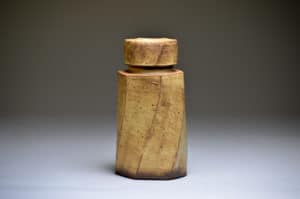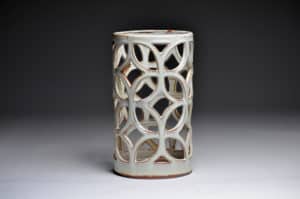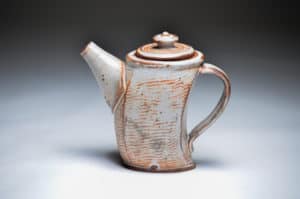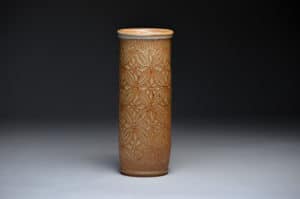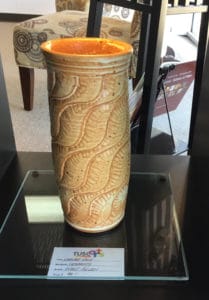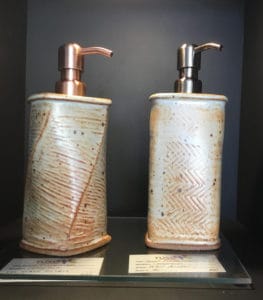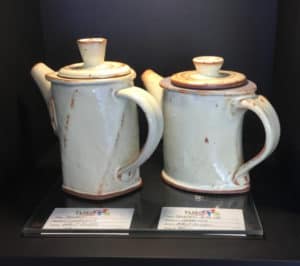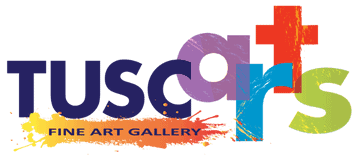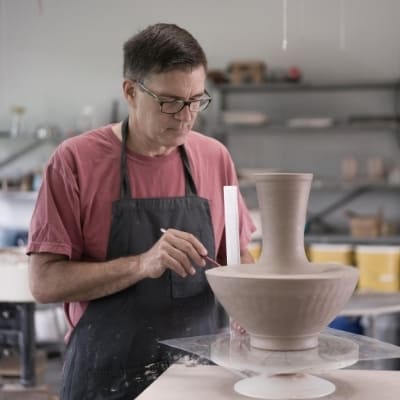How would you describe your art?
My body of work includes both the ornamental and the functional, but mainly focuses on useful, practical pieces. This is drawn from my own enjoyment of using handmade items such as plates or mugs in everyday life and more so, when I know the potter who made them.
Surface texture referencing floral or geometric patterns is something that I often like to incorporate in my pieces. I appreciate the way that certain glazes highlight these surface details, increasing the visual interest of the piece. I introduce texture by hand carving with gouges, press stamps, trimming marks, or throwing lines. The use of geometric patterns is also influenced by my interest in wood carving and my career as a mechanical engineer working in tire tread pattern development for a large tire company. These additional details provide another design element that amplifies the overall level of craftmanship contained in the piece.
When did you start making art and why?
I have always enjoyed being creative with my hands, from fixing cars to photography, gardening, wood turning, carving, and drawing. My journey with clay began with my wife, Nancy. Before we were married, she worked as a potter in rural Kentucky, promoting it as a potential livelihood for the community. She kept her electric kiln and potter’s wheel, and for about 10 years, they moved with us unused from house to house while we raised our six children! Eventually I asked her to teach me how to throw pots on the wheel. I subsequently took pottery classes at the local university and art museum. I have since attended ceramic workshops at Penland School of Craft (NC), Anderson Ranch Arts Center (CO), and Touchstone Center for Crafts (PA). Over the past years it has grown from a hobby to my passion and a full-time creative enterprise.
Describe your creative process.
I typically try to develop my ideas in a sketch book before working in clay. Next, a series of prototypes are made in order to refine the idea while improving the technique. Creating a series of pots based on an idea helps the design crystalize and express what I want to communicate.
After the first firing there is another decision process in selecting the glaze color and properties that will best fit the piece. After firing, each piece is photographed and archived to my digital portfolio.
Since I have dabbled with several artistic hobbies over the years, I find that other mediums sometimes play a part in the process of creating ceramic work. I especially enjoy incorporating carving, wood accents and assembling various pieces and shapes.
What are your favorite materials or mediums to work with?
The majority of my work is made with brown stoneware clay from Standard Ceramic in Pittsburgh. It is an excellent clay for throwing and hand building. All work is fired twice, once to 1888 deg F in an electric kiln to partially vitrify and to open the clay body to receive the glaze.
I create my own glazes from basic materials and chemicals and test different recipes to find new color variations. I also enjoy experimenting with various underglazes, slips and wax resist as well as different methods of applying glazes, from dipping to spraying. After applying the glaze, the piece is fired again in a gas kiln to a temperature about 2300 deg F to melt the glaze and completely vitrify the clay body.
I have also experimented with alternative firings such as raku and saggar, and currently I am working with several other potters to build a wood kiln in Pennsylvania at my brother in law’s farm. Our first firing should be sometime in the fall and I am excited about the possibilities this different firing protocol will have on my work.
What inspires you to create?
At times, my ideas begin with a need in the kitchen or for our décor – other times with a design that appeals to me, a beauty of nature, or seeing another’s work.
Most of the time I have a plan and I know what I will be working on that day, but this isn’t always the case. A wise potter once said that in times of creative dryness or lack of inspiration, just show up in the studio. Just being in the studio allows me to reflect on my influences and what pots have resonated with me in the past. Another enormous source of inspiration is being around other artists, a reason I have found workshops to be so beneficial to my artistic development. I follow quite a few ceramic artists on social media. Seeing their work is also a source of inspiration and direction.
Contact Information
330-612-4088
[email protected]
